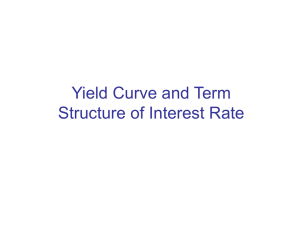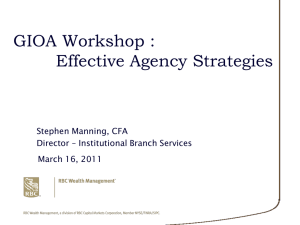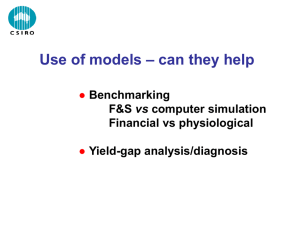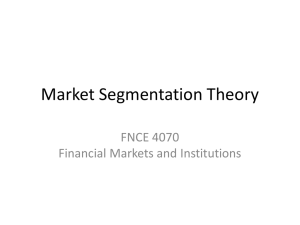Chapter 5
advertisement
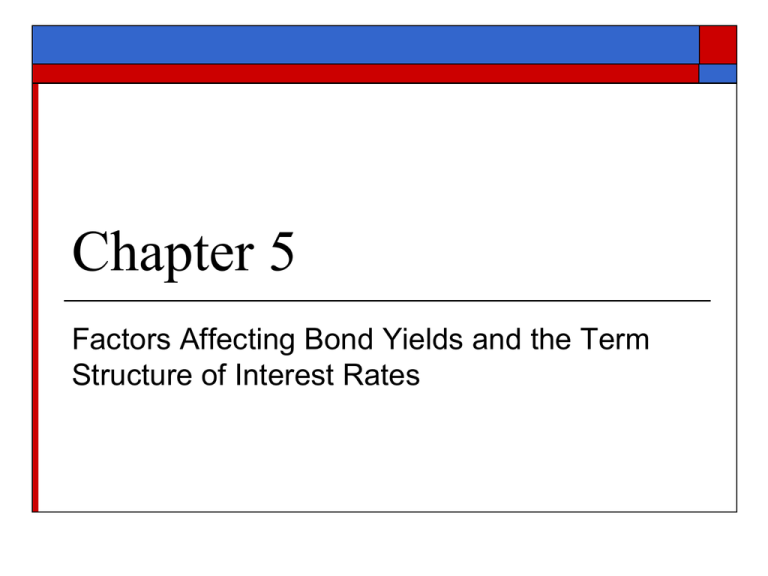
Chapter 5 Factors Affecting Bond Yields and the Term Structure of Interest Rates Introduction We have spent a lot of time discussing the required yield (interest rate) on a bond. However there is an IMPORTANT point to remember: There is no single market yield. Every bond has it’s own yield. In this chapter, we learn about the factors that affect bond yields. Two Ways to Get Money 1. Buy it: Earn it in productive activities (equity). 2. Rent it: An interest rate is the price of renting money (debt). Like all other prices, interest rates reflect supply and demand. That is, the supply and demand for renting money. There is an interest rate for each rental period. Supply and Demand of Money Interest rate (r) r S$ Why is D$ downward sloping? • If r - less money demanded • If r - more money demanded D$ Quantity of money U.S. Treasuries Viewed as having zero default risk Largest and most liquid market Lowest rate (yield) Rate (yield) is the base or benchmark rate Treasury yields Minimum yield investors will accept Other bonds trade at spreads over the Treasury yield Examples of current U.S. Treasury rates Bond Yield All bond yields can be expressed as: Bond yield = Base interest rate + Spread Bond yield = Base interest rate + Risk premium Our first task is to understand the base rate (also called the benchmark rate) Then we move to the spread or risk premium. Base Rate Minimum rate an investor would ever accept for investing in non-Treasury securities. It is measured as the YTM of a comparable on-the-run Treasury security. Example: US Treasury yields on February 20, 2009: Maturity 1-Mo 3-Mo 6-Mo 1-Yr 2-Yr 3-Yr 5-Yr 10-Yr 30-Yr Yield (%) 0.19 0.27 0.48 0.64 0.96 1.30 1.81 2.78 3.56 If you want to invest in a 10-year bond you would never accept less than a 2.78% yield. Spread (Risk Premium) Non-Treasury securities trade at a spread over a similar maturity Treasury security. The spread is a risk premium that reflects the additional risks an investor faces by buying a bond riskier than a Treasury security. How do we measure spreads? Basis points (difference in yields) [most important] Relative yield spread (% difference between yields) Yield ratio (one yield divided by another) Example of Spreads The current 10-year US Treasury Note yields 2.78%. A 10-year AAA rated corporate bond yields 4.96%. What is the spread on the AAA rated bonds? Basis points: 4.96-2.78 = 2.18% or 218 bps Relative yield: 4.96 2.78 0.78% 2.78 Yield ratio: 4.96 1.78% 2.78 Factors Affecting Yield Spreads Type of Issuer (market segments): Different market segments (and sub-segments) have different ability to satisfy contractual obligations. e.g., Municipals, corporates, agencies, etc. Factors Affecting Yield Spreads Credit Worthiness of Issuer: Spread between a Treasury and non-Treasury security that are identical in all respects except for credit quality is call a credit spread. “Identical in all respects” means identical in terms of embedded options, liquidity, taxability, etc. Otherwise the spread reflects the value of items other than default. Factors Affecting Yield Spreads Inclusion of Options (e.g., put and call provisions): Expected Liquidity of Issue: Callable bonds will have ________ spreads over Treasury rates. Putable bonds will have ________ spreads over Treasury rates. Bonds with lower liquidity trade with higher yields because they are more difficult to sell quickly for a fair price (hence are more risky). Treasury securities have very high liquidity, although off-the-runs are less liquid than on-the-runs. Financeability: Treasury bonds can be used as collateral for loans. The more desirable a particular (usually on-the-run) T-bond is, the lower the rate the lender will charge for the loan. Factors Affecting Yield Spreads Term to Maturity: Holding all other bond factors constant, the longer the time until maturity of the bond, the more risky (volatile) it will be when yields change. Taxability of Interest: Coupon payments are taxable at federal and state level. Exception: Municipal bond interest is exempt at the federal level (and state level in some cases). This means municipal securities will pay lower coupon rate (why?) Taxability of Bonds To compare the yields on municipals with yields on taxable bonds, we need to look at after-tax yields: after-tax yield = pretax yield (1 marginal tax rate) Example: A 10-year A-rated corporate bond has a yield of 5.26% and a 10-year A-rated municipal bond has a yield of 3.73%. If your federal tax rate is 35% which bond would you prefer? (assuming all other features of the bonds are equal). Answer: After-tax muni yield is 3.73%. After-tax corporate yield is 3.42% [= 5.26 (1 – 0.35)] Taxability of Bonds We can also determine the yield that must be offered on a taxable bond to give the same after-tax yield as a tax-exempt issue. This is called the equivalent taxable yield: tax-exempt yield equivalent taxable yield = 1 marginal tax rate From the previous example, what taxable yield would offer the same after-tax yield as 3.73% at 35% tax rate: 3.73 5.74% 1 0.35 Term Structure of Interest Rates The relationship between yield and maturity on bonds that are identical in every way except maturity. The term structure is an important tool in valuing bonds. A graphical representation of the term structure is called the yield curve. Term Structure of Interest Rates r Flat Notice: (1) Term structure can change over time. (2) Short-term rates more volatile than long-term rates. Downward sloping Upward sloping (most common) Maturity (term) Where Do We Get A Yield Curve? It may seem a logical first step to use the YTM from bonds of different maturities: C C P 2 (1 y) (1 y) However, YTM is accurate for yield curve construction only if: C Face Value N (1 y) (1 y) N Coupons can be reinvested at a rate equal to YTM. Otherwise YTM is incorrect. Getting Yields for Yield Curve A bond is a portfolio of zero-coupon bonds: C C P 2 (1 y1 ) (1 y2 ) If each coupon is sold as a zero-coupon bond, then each should be discounted at a different rate (reflecting the maturity of the cash flow) C Face Value N (1 yN ) (1 yN ) N 1 year coupon should be discounted at 1-year rate. 2 year coupon should be discounted at 2-year rate. …and so on. Such rates are called spot rates. These are rates on zero-coupon bonds. Theoretical Spot Rate Curve Treasury Bond valuation: portfolios of zero coupon securities. Each cash flow should be discounted by the appropriate yield Cannot use yields on coupon bonds. Need a zero coupon yield curve. There are no zero coupon Treasuries with maturities > 1 year so a curve must be constructed Constructing the Spot Rate Curve Which securities? On the run Treasuries On the run and selected off the run Treasuries All Treasuries Treasury coupon strips Must use increasingly rigorous methods as securities are added What Characteristics Should Spot Rates Have? Spot rates should reflect the required yield for a single cash flow (i.e., a single maturity). Therefore, bonds from which spot rates are determined ideally should have no intermediate cash flows. Be default risk free: Spot rates should reflect the pure supply and demand of loanable funds, not default risk. Where do we get these rates? From risk-free zero-coupon bonds. The spot rate curve comes from risk-free zero-coupon rates. Where Do We Get Risk-Free Zeros? Treasury coupon strips (logical starting point!): Coupons are “stripped” from the bond and sold off separately as individual zero-coupon bonds. Resulting securities are called STRIPS (Separate Trading of Registered Interest and Principal of Securities). Problems with strips: Liquidity of strips is less than the liquidity of the original Treasury securities. Thus, yields on strips reflect a liquidity risk premium. Tax treatment of strips is different from that of original treasury securities. Accrued interest on strips is taxed. Where Else Can We Get Risk-Free Zeros? 1. 2. 3. On-the-run Treasury issues. On-the-run issues along with selected off-the-run Treasury issues. All Treasury coupon securities and bills. The securities above are coupon paying bonds, not zero-coupon bonds! So we will need some techniques to create the spot (zero-coupon) yield curve from coupon-paying bonds. The resulting yield curve is called the theoretical spot rate curve. On-The-Run Treasury Issues We need to extract 60 spot (zero) rates from couponbearing Treasury bonds. Why 60? There are 60 semi-annual coupon payments in 30 years. Complication: There are usually only 6 or so on-the-run Treasuries available. How do we estimate the remaining 54 yields? 1. 2. Construct par yield curve – yield curve constructed from 6 couponbearing Treasuries assuming the bonds are priced at par (yield equal to the coupon rate). Use linear interpolation to fill in gaps. “Convert” the par yield curve to theoretical zero coupon curve using a technique called bootstrapping. Par Yield Curve Construction Suppose we have par yields for two on-the-run Treasuries: 2-year: 6.0% 5-year: 6.6% From these par yields we can interpolate the 2½, 3, 3½, 4, and 4½ year par yields using the following formula: 6.6% 6.0% Yield at longer maturity Yield at shorter maturity 0.10 6 Number of semi-annual periods between maturity points Interpolated yields are: 2½ -year: 6.00% + 0.10 = 6.10% 3-year: 6.10% + 0.10 = 6.20% 3½-year: 6.20% + 0.10 = 6.30% 4-year: 6.30% + 0.10 = 6.40% 4½-year: 6.40% + 0.10 = 6.50% Problems With Interpolation There are large gaps between the 5-year and 10-year bonds and 10-year and 30-year bonds. Using such long distances between maturities can reduce the accuracy of interpolation. On-the-runs may be “special” in that they are desirable as collateral for loans. This can distort yields. Solution? In addition to the on-the-runs, use some selected off-the-run Treasuries to help fill in the gaps. Usually the 20 and 25-year off-the-runs are used. Bootstrapping Bootstrapping enables us to take (par) yields from coupon bonds and generate a spot yield curve. Bootstrapping uses the concept that a coupon-bearing bond is a portfolio of zero-coupon bonds and should be priced accordingly. Best illustrated by an example. Example of Bootstrapping Suppose we have the following on-the-run Treasury securities (coupons paid semi-annually): Bond A B C D Maturity (in years) 0.50 1.00 1.50 2.00 Yield/ Coupon Rate 5.25 5.50 5.75 6.00 All bonds have a face value of $100. The first 2 bonds are zero coupon bonds (why?). Our goal: Extract zero-coupon yields. Bond A B C D Solution Yield/ Coupon Rate 5.25 5.50 5.75 6.00 Since the first 2 bonds are zero-coupon bonds (i.e., T-bills) their par rates are spot rates. The next spot rate we need is the 1½ year rate: Since it has a 5.75% coupon rate, the coupon on this bond should be $2.875 every six months. The value of this bond is $100 since it is based on par yields. $100 $100 Maturity (in years) 0.50 1.00 1.50 2.00 2.875 2.875 102.875 (1 z1 ) (1 z2 )2 (1 z3 )3 2.875 2.875 102.875 (1.02625) (1.0275) 2 (1 z3 )3 Solving for z3 we get: 0.028798 Double the yield to get an annual spot yield: 0.0576 (or 5.76%). Bond A B C D Solution Yield/ Coupon Rate 5.25 5.50 5.76 6.00 Now we find the spot yield for the 2-year maturity: Since it has a 6.0% coupon rate, the coupon on this bond should be $3.00 every six months. So, we can now find z4: $100 $100 Maturity (in years) 0.50 1.00 1.50 2.00 3.00 3.00 3.00 103.00 (1 z1 ) (1 z2 ) 2 (1 z3 )3 (1 z4 ) 4 3.00 3.00 3.00 103.00 (1.02625) (1.0275) 2 (1028798)3 (1 z4 ) 4 Solving for z4 we get: 0.030095 Double the yield to get an annual spot yield: 0.062 (or 6.02%). Comments On Bootstrapping This process continues until the entire spot yield curve is constructed. The bootstrapped yields are yields the market would apply to zero-coupon Treasury bonds, if such securities existed. All Treasury Securities Using only on-the-run issues (even with selected off-therun issues) fails to recognize all the information contained in Treasury security prices. Some argue that all Treasury securities and T-bills should be used to construct the theoretical spot yield curve. If all securities are used, methodologies other than bootstrapping must be used because there may be more than one yield for each maturity: The most common methodology is exponential spline fitting. Revisiting the Theoretical Spot Curve Let’s return to the base rate in the formula: Bond yield = Base interest rate + Spread Earlier, we said the base rate came from the YTM of an on-the-run Treasury security. We have to modify that explanation. The base rate comes from the theoretical spot rate curve that we just learned to construct. Example using theoretical spot rates (exhibit 5-7) Period Year Cash Flow Spot Rate (%) PV of $1 at PV of CF 1 0.5 5 5.25 0.974421 4.872107 2 1 5 5.5 0.947188 4.735942 3 1.5 5 5.76 0.918351 4.591756 4 2 5 6.02 0.888156 4.440782 5 2.5 5 6.28 0.856724 4.283619 6 3 5 6.55 0.824206 4.12103 7 3.5 5 6.82 0.790757 3.953783 8 4 5 6.87 0.763256 3.81628 9 4.5 5 7.09 0.730718 3.653589 10 5 5 7.2 0.701952 3.509758 11 5.5 5 7.26 0.675697 3.378483 12 6 5 7.31 0.650028 3.250138 13 6.5 5 7.43 0.622448 3.112238 14 7 5 7.48 0.597889 2.989446 15 7.5 5 7.54 0.573919 2.869594 16 8 5 7.67 0.547625 2.738125 17 8.5 5 7.8 0.521766 2.608831 18 9 5 7.79 0.502665 2.513325 19 9.5 5 7.93 0.477729 2.388643 20 10 105 8.07 0.453268 47.59317 Theoretical Value = 115.4206 Forward Interest Rates Borrowers and lenders often enter into agreements to make loans in the future. This creates a need for a forward interest rate. Forward rates are interest rates implied by current spot rates of interest. A forward rate is often viewed as the market’s consensus for future interest rates. Example of Forward Rates Consider the following zero rates: Period (n) 1 2 3 4 5 Zero Rate z1 = 5.25 z2 = 5.50 z3 = 5.76 z4 = 6.02 z5 = 6.28 zT = The current T-period spot (zero) interest rate (i.e., annual interest rate that prevails from T0 to time T). Forward Interest Rates Spot Rate z1 = 5.25 z2 = 5.50 z3 = 5.76 z4 = 6.02 z5 = 6.28 Consider the following two strategies: (1) Invest $100 at 2.75% for 1 year (i.e., 2 six-month periods: Period (n) 1 2 3 4 5 $100(1.0275)2 = $105.5756. (2) Invest $100 at 2.625% for 6 months and then reinvest the funds for 6 more months at the prevailing rate: At the end of 6 months we would have: $100(1.02625) = $102.625 At the end of 1 year we would have: $102.625(1 + f) = ? We don’t know what f is (it’s a forward rate). However… 100(1.0275)2 = 100(1.02625)(1 + f): Solving for f we get: f = 2.875% To annualize, multiply: 5.75% 5.75% is the market’s consensus for the six-month rate six months from now. These must be equal How to use the forward rate… If the six-month rate six months from now is less (greater) than 5.75%, then the total dollars at the end of one year would be higher (lower) by investing in the one-year instrument. Forward rates cont… In general: (1 zt 1 )t 1 ft 1 t (1 zt ) where ft is the 6-month forward rate beginning t 6-month periods from now. Generalizing Our Result… The relationship between the t-period spot rate, current six-month spot rate, and the six-month forward rates is: (1 zt )t (1 z1 )(1 f1 )(1 f2 ) zt t (1 z1 )(1 f1 )(1 f 2 ) (1 ft 1 ) (1 ft 1 ) 1 where ft is the 6-month forward rate beginning t 6-month periods from now. t=0 t=1 z1 t=2 f1 t=3 f2 t=4 f3 Example Suppose we have the following rates: z1 = 0.0250 f1 = 0.0237 f2 = 0.0255 f3 = 0.0262 We can see how the 2-year spot rate is related to the various sixmonth forward rates: z4 [(1.0250)(1.0237)(1.0255)(1.0262)]1/ 4 1 0.0251 (or 5.02%) Calculating forward rates Invest $100 in each strategy Alternative 1 payoff at end of year Alternative 2 payoff at end of year $100(1 + z2)2 $100(1 + z1)(1+f) Investors are indifferent if: $100 (1 + z2)2 = $100(1 + z1)(1+f) f = ((1 + z2)2 /(1 + z1)) -1 Theories of the Term Structure If we plot the yield curve, what will it look like? Typical patterns are: Upward sloping (called normal or positive yield curve) Downward sloping (called inverted yield curve) Flat We want a theory that explains two things: What explains the shape of the yield curve? What explains two empirical regularities we observe: 1. Most of the time the yield curve is upward sloping. 2. Sometimes the yield curve is downward sloping Expectations-Based Theories Expectations Theories: Three theories: (1) pure, (2) liquidity, (3) preferred habitat Assume that forward rates are related to the market’s expectations about future short-term rates. The various theories differ in whether other factors also affect forward rates. Market Segmentation Theory. Pure Expectations Theory Under the Pure Expectations Theory, forward rates equal expected future spot rates. [ft = E(zt)] Thus, the yield curve reflects the market’s current expectations of future short-term rates: Rising yield curve → market expects ST rates to rise in the future. Flat yield curve → market expects rates to be mostly constant. Declining yield curve → market expects ST rates to decline. The shape of the yield curve results from bond prices adjusting to investor expectations about the future level of interest rates. Example of How Expectations Affect Shape of Yield Curve Suppose the yield curve is flat at 5% and investors expect interest rates to increase over the next year to 7%. An investor with a two-year horizon would weigh two investing strategies: 1. 2. Buy a two-year bond and hold it for two years (earning 5%) Buy a one-year bond now and a 7% bond in one year (earning about 6% over two years) Investors would choose alternative #2 and ignore #1: 1-year bond prices would increase, pushing down 1-year yields. 2-year bond prices would decline, pushing up 2-year yields. The yield curve would go from flat to upward sloping. Strengths and Weaknesses of PET Strengths: Weaknesses: PET is consistent with the observation that yields tend to move together in the yield curve. PET does not explain the persistent upward slope of the yield curve. Risk factors are ignored in PET, but seem to play a role in shaping the yield curve. What risk factors are ignored by PET? Reinvestment risk Price risk Liquidity (term) risk. Liquidity Theory Investors are averse to risk. σLTB > σSTB, so investors demand the less volatile ST bonds unless compensated for buying LT bonds. Therefore, liquidity theory says investors must be paid a risk premium for investing in LT bonds: And, the risk premium rises uniformly with maturity. LT bond yields > ST bond yields and the yield curve will be upward sloping. Strength of Liquidity Theory: Consistent with the persistent positive slope of the yield curve. Preferred Habitat Theory Suggests that different investors have a different “maturity preference” for investing in bonds. e.g., Insurance companies prefer to invest in long-term bonds whereas banks prefer shorter-term instruments. However, investors will leave their maturity habitat if compensated (i.e., paid a risk premium) for doing so. Firms issuing bonds in an “undesirable” maturity range will have to offer a risk premium to attract investors. Shape of yield curve is based on expectations as well as risk premiums offered in different maturity habitats. Market Segmentation Theory Similar to the Preferred Habitat Theory except investors are not willing to leave their preferred maturity segment. Each maturity segment of the yield curve has it’s own supply and demand for funds that is not related to any other segment. Reality What are the main influences of the shape of the Treasury yield curve? Research shows there are three main influences: Expectations of future interest rate changes. Bond risk premiums—demand for long-term bonds pushes up prices and reduces yields relative to what we would expect from expectations alone. Convexity bias—attractive convexity properties of LT bonds pushes LT bond prices up (and yields down) relative to a pure expectations driven yield curve.
